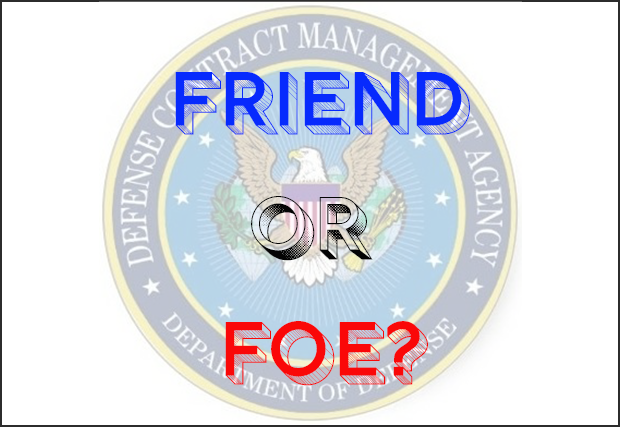 Is DCMA A Contractor’s “Friend or Foe?”
Is DCMA A Contractor’s “Friend or Foe?”
I’ll answer this provocative question now. DCMA, local and headquarters, are an EVM contractor’s “friend” with remarkable, but not unlimited, patience. When required, DCMA can become the contractor’s “tough love” friend.
DCMA and the contractor share the same interests – successful contract performance. DCMA is part of a triad that includes the Government’s program team, the contractor’s program team and their DCMA counterparts.
The title “Defense Contract Management Agency” reminds me of “grilled cheese sandwich” – the recipe and the product are in the name – “contract management” leads to well managed contracts.
EAC Vignette – Part One:
Contractor A has learned that their collocated DCMA has concerns about the company’s EAC process and resulting declared EACs. The company has learned that a Level III CAR on GL # 27 is being considered. Contractor A’s senior management decides to replace their EVM Core Leader with “new blood” to improve the company’s “relationship” with DCMA and avoid a Level III CAR.
Contractor A’s new EVM leader meets with her team and with the program managers that have an EVM contractual requirement. Company A’s new EVM leader is told that DCMA’s EAC concerns are a new issue. The company’s new EVM leader asks to meet with her DCMA counterpart to discuss their GL # 27 concerns, and to present a draft of a Corrective Action Plan (CAP).
During the meeting with DCMA’s EVM leader she mentions that the EAC concerns were a surprise to the company. The company’s new EVM leader briefs her draft CAP to her DCMA counterpart.
After the draft CAP has been briefed, the DCMA EVM leader comments, “your draft CAP is a good start. After I have time to fully digest your draft CAP I will send my comments and suggestions. As for being surprised by our EAC concerns, here is a file with 3+ years of letters, emails, meeting minutes from DCMA to your company outlining our continuing and growing concerns with your company’s EAC process.”
EAC Vignette – Part Two:
DCMA issued a Level III Corrective Action Request (CAR) to the contractor and is considering withholdings as an incentive for the company to quickly improve their EAC processes.
As promised, the DCMA EVM leader sent the following note to the company’s new EVM leader:
“I sent your draft GL # 27 CAP to my team for their comments and recommendations. My team’s key recommendations are:
1). Identify the weaknesses in your existing EAC processes. For each weakness, identify a corrective action. As much as possible, “mistake proof” your new processes. You should consider a review of several 100% complete contracts, and “replay” those contracts month-by-month using your new EAC processes to test their effectiveness.
2). As noted in our CAR, the company is required to report progress on the Corrective Action Plan (CAP). You should treat your CAP as a program. At a minimum, you should have an IMS and use appropriate earned value techniques to measure progress.
3). A sister division in your parent corporation, has a very mature and effective EAC process. You should considering asking for their assistance as you develop your CAP and begin its execution.
4). If you have questions as you execute your CAP, please don’t hesitate to contact me. If I don’t know the answer to your question, I’ll find someone that does know the answer and will share it with you.”
Personal Observations:
Based on my 32 years as an employee of defense contractors, and 7 years in earned value consulting, I offer the following:
1). DCMA “local” knows your company much better than you might think.
2). DCMA “headquarters” has knowledge and insight into many companies. From DCMA’s website: “We are the independent eyes and ears of DoD and its partners, delivering actionable acquisition insight from the factory floor to the front line …. around the world.”
3). A CAR from DCMA informs the company of “what” needs corrected but not “how” to correct the issue. That said, DCMA knows what will or will not work. Maintain a dialogue with DCMA.
4). “Compliance” is a lower bound for performance. DCMA will not object if a company decides to improve well beyond mere compliance.
5). Please consider the possibility that what may appear to be a “new” problem for your company, may have already been solved by another company. Find who has already solved your “new” problem. Ask for help.
DCMA will never be a foe. Never.

Good article. After 37 years as a contractor and 5 years as a consultant, I have witnessed the relationship with DCMA mismanaged more often than not by contractors. Often it is not the fault of the EVM Leader but the Executives and especially Program Manager. This is a true case of the often referenced practice of walk the talk being poorly executed. The program and the DCMA must see company and program leadership “using” EVM as an essential and often used tool to run their program. This is how an EVM culture is built and maintained. Memos, Letters and especially a Level III CAR would not be a routine event, but a very loud warning of our program potentially crashing and burning. Final note; the DCMA gains nothing and in fact is also hurt by the failure of a program under their surveillance. Remember that whenever you have an opportunity to listen and contemplate their observations.
i would have to say they are more of a foe than they are a freind. they make it extrememly difficult to work with them vs the private sector. were actaully going after more commercial work now becuse dcma seems to find something everytime to delay delivery.